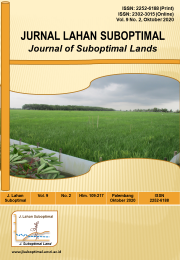Effects of Water Table, Population Density and Transplanting Time on Vegetative Growth of Black Sticky Rice at Floating Seedbed Method
DOI:
https://doi.org/10.33230/JLSO.9.2.2020.482Keywords:
black sticky rice, floating system, population density, seedling preparation, transplanting timeAbstract
Ria RP, Lakitan B, Negara ZP. 2020. Effects of water table, seedling density and transplanting time on vegetative growth of black sticky rice at floating seedbed. Jurnal Lahan Suboptimal : Journal of Suboptimal Lands 9(2): 167-174.
Study on black sticky rice cultivation in South Sumatera is seldom carry out. The objective of this study was to evaluate the effect of water table and population density on the growth of rice during seedling preparation at floating seedbed; furthermore, this study aimed to evaluate the effect of transplanting time on vegetative growth of black sticky rice. The research was started in May 2018 in Palembang. Black sticky variety used in this research was Toraja variety. The raft used is made from 1,5 l plastic bottles which are arranged to reach 2x1 meters in size. This study was conducted by two stages. The first stage was for water table and population density treatments laid on split plot design. The second stage was for transplanting time utilizing completely randomized factorial design. Statistically, results showed water table and population density significantly influensced root length of black sticky rice and transplanting time 14 DAS haad an effect on the leaf length , leaf width and leaf area.
Downloads
Additional Files
Published
How to Cite
Issue
Section
License
Copyright (c) 2020 Rofiqoh Purnama Ria, Benyamin Lakitan, Zaidan P. Negara

This work is licensed under a Creative Commons Attribution-NonCommercial-ShareAlike 4.0 International License.













